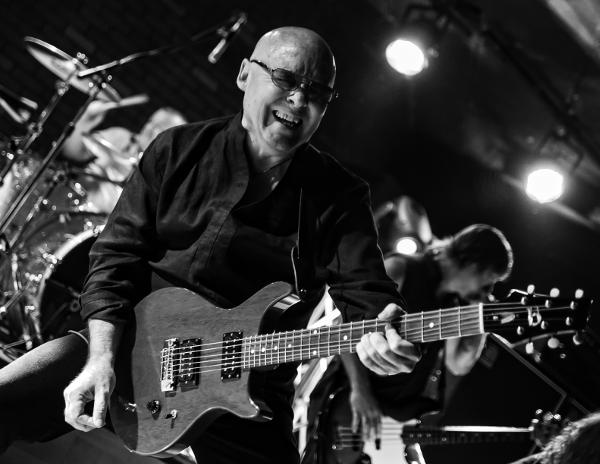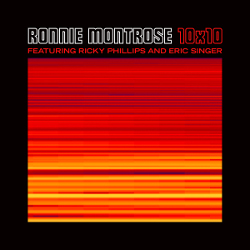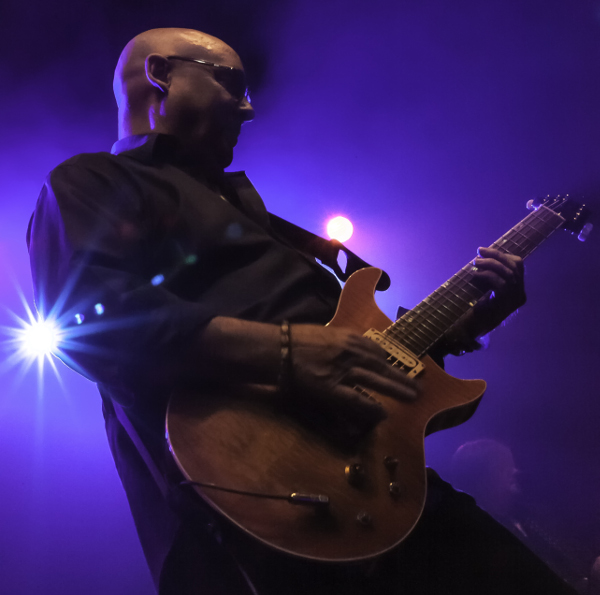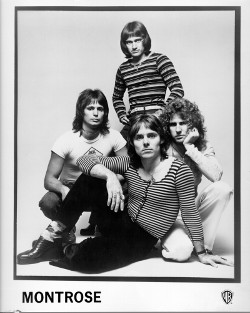Ronnie Montrose Rocks the Nation with a Fabulous Final Studio Album, 10x10

“His guitar speaks for itself.” It’s a phrase that could be applied to many a dominant and influential guitar player of the rock era, but it’s no accident it was also stickered on the front of albums bearing the name of Bay Area guitar legend Ronnie Montrose. Montrose initially made his mark laying down indelible riffs for the likes of Van Morrison (“Wild Night”) and The Edgar Winter Group (“Free Ride,” “Frankenstein”), but when he joined forces with a then-unknown Sammy Hagar to form Montrose in 1973, he shepherded a band immediately described as America’s answer to Led Zeppelin, Black Sabbath, and Deep Purple, all rolled into one. (“Rock the Nation,” indeed.)
“Musically, Ronnie really had a fiery thing about the way he played,” Hagar observes. “He came out of the Jimmy Page/Jeff Beck era before the Eddie Van Halens and Joe Satrianis of the world arrived. He was one of those guys. He was right there with those guys. And I’m still humbled by what other musicians tell me every time Montrose is brought up. I probably get as many compliments and shout-outs about Montrose as I do Van Halen. I really do.”
 Montrose himself eventually transitioned into a fine solo career, doing some of his best work onstage alongside bassist Ricky Phillips (Styx, The Babys, Bad English) and drummer Eric Singer (Kiss, Alice Cooper) in the early 2000s. Montrose also had a singular vision for an album the trio started cutting together around that time, but sadly, he passed away in 2012 before it was completed. In his stead, Phillips gamely picked up the gauntlet and duly poured his own blood, sweat, tears, and golden ears into making sure the album ultimately dubbed 10x10 — so named to reflect the artist’s wish to have its 10 tracks sung by 10 different vocalists — accurately honored the Montrose mantra.
Montrose himself eventually transitioned into a fine solo career, doing some of his best work onstage alongside bassist Ricky Phillips (Styx, The Babys, Bad English) and drummer Eric Singer (Kiss, Alice Cooper) in the early 2000s. Montrose also had a singular vision for an album the trio started cutting together around that time, but sadly, he passed away in 2012 before it was completed. In his stead, Phillips gamely picked up the gauntlet and duly poured his own blood, sweat, tears, and golden ears into making sure the album ultimately dubbed 10x10 — so named to reflect the artist’s wish to have its 10 tracks sung by 10 different vocalists — accurately honored the Montrose mantra.
To that end, 10x10 (to be released by Rhino on September 29) is a rousing sonic success, not only featuring great guest guitar solos from the likes of Toto’s Steve Lukather, Rick Derringer, Def Leppard’s Phil Collen, and Joe Bonamassa, but also stellar vocal contributions from the aforementioned Hagar (“Color Blind”), Styx’s Tommy Shaw (“Strong Enough”), Gamma’s Davey Pattison (“Head on Straight”), and founding Santana/Journey keyboard maestro Gregg Rolie (“I’m Not Lying”), to name but a few.
“It’s a whole body of work,” believes Singer. “The overall record has a vibe that’s important to not go unnoticed. There was a certain chemistry going on between Ricky, Ronnie, and myself, and it was captured the way they did those early Montrose records — live, and with no click tracks; none of that stuff. To me, that’s the real underlying element people should pay attention to on 10x10.” Concludes Hagar, “10x10 is a great, cool project. And it’s always valuable to have something like this, rather than digging up some stuff from his past. This album is Ronnie’s last work, and it was something he truly had a vision for.” (Amen, brothers Eric and Sam.)
I recently got on the line with executive producer Phillips, 64, and Singer, 58, to discuss all things Ronnie. Have you heard the news? 10x10 ensures there will be some good rockin’ tonight.
Mike Mettler: Ricky, where did you guys cut 10x10?
Ricky Phillips: We recorded in Doug Messenger’s studio in North Hollywood, purportedly with the tape machine Pink Floyd used to make [1979’s] The Wall. Ronnie was so wonderfully quirky in the studio. It took him three days to get the amplifiers set, all the wires straight enough, and the right carpet to go in front of everything. (laughs) Ronnie would explain a song and how he wanted it to go, and we would do it. We played it one time, and it was the only time it was ever performed.
Mettler: How did you arrive at the idea of going with 10 different vocalists?
Phillips: Ronnie called me up one day and said, “I have a concept. We call the record 10x10. It’ll have the 10 tracks the three of us did, with 10 different singers.” I said, “That’s great, Ronnie, but we couldn’t find one singer. How are we going to find 10?” He then started naming off all these singers — people he loved like Edgar and Sammy, and other people he’d worked with over the years — and then he said, “We go until we get the right ones.”
After he passed, I had to carry on with what Ronnie wanted, because he was such a purist. The songs were cut to 2-inch tape and then transferred to digital, but I really needed it to be a cohesive record. I’ve done enough records to know how easily the levels of 10 different singers can sound disjointed if you don’t stay on top of the production.
Eric Singer: I have to give a lot of credit to Ricky Phillips. Ricky really wanted to see this thing through. It was more for Ronnie than just for himself, or for ourselves. We really believed what we had originally captured had a certain vibe and a certain magic to the people in that room when it was created. We felt like, “Hey, this thing needs to get done. We need to see this thing through, for every good reason.”
And it was done for all the right reasons, not monetary reasons. Everybody thinks that’s part of the equation, but that’s just not true. We wanted to do it because we knew Ronnie would have loved to see it realized. I think he’d be really happy, and really proud.
We also did it for our own selfish reasons, because, well, we thought it was cool! (chuckles) We thought people should get to hear this. There are a lot of great people on this record, and all of it is from a place of love and from a creative point of view, to be perfectly honest with you.
I think when people hear 10x10, especially if you have a good stereo and a good set of headphones, you can crank it up, and you’ll really appreciate what we were doing — as well as the overall intent.

Phillips: Eric and I would bend whatever we were doing in order to work with Ronnie, because we both came together in thinking we couldn’t believe how Ronnie hadn’t seemed to get his just due — what he gave to rock & roll in terms of harmony playing and that hard-rock edge. Jeff Beck is in that same category of people who truly want to break ground and not repeat themselves. They’re the ones who leave themselves open to maybe not the obvious successes of a repeated performance.
I remember people saying how Montrose was our answer to Led Zeppelin, which is a bold statement. But I think we all were so influenced by what was going on in England, and very few American bands were able to fire back. But Ronnie, with Sammy [Hagar], Denny [Carmassi, Montrose’s drummer], and [bassist] Bill Church — they were certainly firing back.
Singer: Back then — and I grew up in that era, so I was there! — people referred to that first Montrose album [the aforementioned 1973 release, Montrose] as, “Oh, they’re like the American Led Zeppelin.” Sammy kind of looked like Robert Plant, and Ronnie had Jimmy Page down. Some of those riffs were very Zeppelinesque, but they definitely had their own sound, and did it in their own way. Ronnie was not afraid to wear his influences on his sleeves, but he definitely turned them into his own soup. At the same time, he clearly had his own voice.
[We should also note here that Rhino will be re-releasing both Montrose and its 1974 follow-up, Paper Money — each album remastered, and with bonus tracks — on October 13.]
Mettler: One thing that will clearly come out of 10x10 getting into the marketplace is there will be a new generation of listeners who may have only heard Ronnie’s name in passing, and now they’re going to find out how important and how underrated he is in the overall picture — wouldn’t you agree?
Singer: Yep! If somebody really wanted to get a good understanding of Ronnie’s body of work and I had to pick three records for them to do it with, I’d tell them to start with the first Montrose album, and then get The Edgar Winter Group’s They Only Come Out at Night (1972). And don’t just listen to “Free Ride” and “Frankenstein” — listen to the whole record, and be mindful of the mixes. Ronnie’s guitar was down low in the mixes in those days, lower than I personally prefer.
And third, you also have to get Open Fire (1978), the instrumental record that had “Town Without Pity,” which was a hit at the time. That was a great record, and, in fact, on that tour — here’s a little piece of history for you — Ronnie Montrose was opening for Journey doing all those instrumental songs with Steve Smith as his drummer, and that’s how Journey found him.
Mettler: Oh yeah, Gregg Rolie told me all about that. How would you personally describe Ronnie’s style as a player?
Singer: Well, obviously, there’s the Jimmy Page influence there like I mentioned before, but I will say this. I’ve played with some great guitar players like [Queen’s] Brian May and [Black Sabbath’s] Tony Iommi. And the one thing I always admired, and that I would have to acknowledge and recognize, is that Ronnie had his own bag of tricks, if you will. He had his own sound, and his own licks.
Some guys, like Tony Iommi, have their own sound and their own riffs. And some have songwriting skills too, like Brian May, who has an unbelievable, unique sound. I would say Ronnie’s in good company with that type of musician — those who have a true, individual voice on the instrument.
Ronnie has some certain riffs and licks that are uniquely Ronnie Montrose. As soon as you hear them, you go, “Yeah, that’s a Ronnie Montrose lick.”
Mettler: One thing Ricky and I talked about was how the three of you had a certain chemistry and intuition whenever you played together, so the bed of all these tracks on 10x10 gives all the vocalists and guitar players room to springboard off of, because they then had such a strong foundation to work with in the first place.
Singer: Yeah, well, we had a good vibe together. At the time, I really loved playing with Ronnie, and we all got along really well. I think Ronnie would have loved to have kept that particular lineup going together, but I got back to working with Kiss and Ricky Phillips joined Styx [in October 2003], and the rest is history.
 Mettler: What’s Ronnie’s legacy as a player, in your opinion?
Mettler: What’s Ronnie’s legacy as a player, in your opinion?
Singer: I would say Ronnie is one of the great American guitar players. Everybody always talks about [Jimi] Hendrix, who is American, but he made it out of England and the whole British Invasion because it wasn’t happening here, not on that level.
Mettler: Both Glenn Hughes and Phil Collen told me essentially the same thing about Ronnie, from their points of view as two players who came from the other side of The Pond and were active in that era.
Singer: Everybody always thinks of the big three of the old days — Beck, Page, and Clapton, and then there was Hendrix, Tony Iommi, Brian May, [Deep Purple’s] Ritchie Blackmore, and on and on and on.
There were also some great American guitar players like Joe Walsh, Leslie West, and Ronnie Montrose. That whole gamut of guys here in America were all also very influential, and very great. You can’t discount those guys’ contributions.
Phillips: Ronnie liked to keep it real. He would say, “Those aren’t mistakes. That’s life. That’s music breathing.” That’s the way he looked at it, so I tried to respect that and keep the 10x10 edits to the minimum. I owned my own decisions, but I got to the point of sitting there thinking, “If Ronnie were here right now, what would he do?”
Mettler: Sounds like it was a WWRD kind of thing — “What Would Ronnie Do”?
Phillips: (laughs) Yeah! Often times, it wouldn’t be what I’d do, it would be what Ronnie would do. He “told” me. We had a commonality in the guitar players we liked.
Singer: I bought all the Montrose records, because I really was a big Montrose fan. For me on a personal level, and also from the musical aspect of it, getting to work with Ronnie was a real highlight. It was an honor to play with Ronnie, even if it was only for a short time. I’m really happy something we worked on together will be put out for infinity, as they say.
Phillips: We were excited to finish the 10x10 project for him — and for everyone, really. Ronnie was definitely on my mind through the heart of the work. Sometimes I went with my gut, but like I said, there were decisions where I knew what Ronnie would do if he were there. I would feel Ronnie calling it in from Space Station #5, giving me the nudge for making those decisions. At the end of it, I finally realized: all the right people are on the record.








































